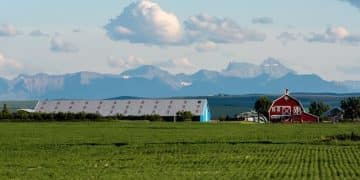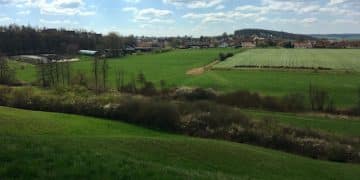Latest USDA Grants for Sustainable Soil Management in the US
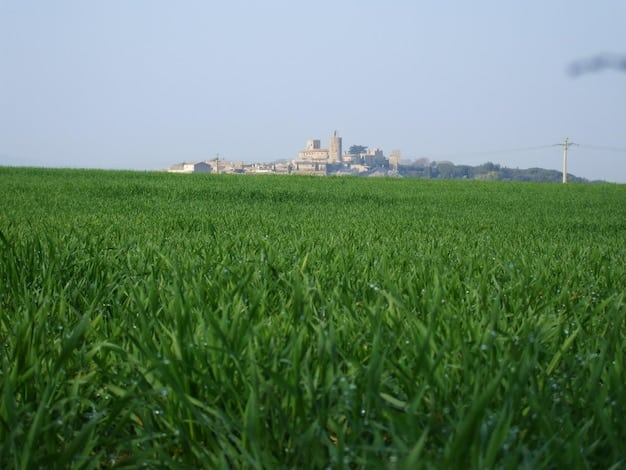
The latest USDA grants for sustainable soil management practices in the US support farmers and ranchers in implementing innovative conservation strategies, enhancing soil health, and promoting environmental stewardship through various funding programs.
Discover What are the Latest USDA Grants for Sustainable Soil Management Practices in the US, empowering farmers to enhance soil health, increase productivity, and foster environmental sustainability.
Understanding the Importance of Sustainable Soil Management
Sustainable soil management is crucial for maintaining healthy ecosystems, supporting agricultural productivity, and mitigating climate change. It involves practices that improve soil health, reduce erosion, and enhance water infiltration, creating resilient and productive agricultural landscapes. These practices not only benefit the environment but also contribute to long-term economic stability for farmers and ranchers.
The USDA recognizes the vital role of sustainable soil management and offers various grant programs to support its implementation across the United States. These grants help farmers adopt innovative techniques and technologies, fostering a more sustainable and resilient agricultural sector.
Key Benefits of Sustainable Soil Management
Sustainable soil management offers a multitude of benefits, ranging from improved crop yields to enhanced environmental quality. Understanding these advantages can help farmers make informed decisions about adopting sustainable practices.
- Improved Crop Yields: Healthy soils provide essential nutrients and water, leading to increased crop productivity.
- Reduced Erosion: Sustainable practices minimize soil loss, preserving valuable topsoil and preventing sedimentation in waterways.
- Enhanced Water Infiltration: Healthy soils improve water absorption, reducing runoff and enhancing groundwater recharge.
- Carbon Sequestration: Sustainable practices promote carbon storage in the soil, mitigating climate change.
By adopting sustainable soil management practices, farmers can create a more productive and environmentally friendly agricultural system. These practices contribute to long-term sustainability and resilience in the face of environmental challenges.
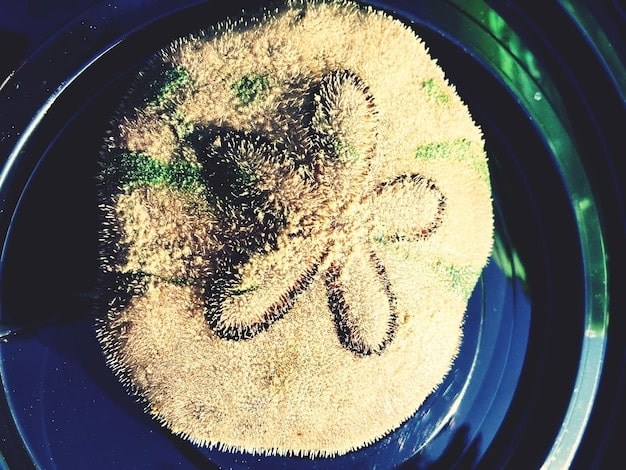
Overview of USDA Grant Programs for Soil Health
The USDA provides a range of grant programs designed to support sustainable soil management practices. These programs offer financial assistance, technical support, and educational resources to help farmers implement conservation strategies and improve soil health. Understanding the different programs and their eligibility requirements is essential for accessing these valuable resources.
Some of the key USDA grant programs for soil health include the Environmental Quality Incentives Program (EQIP), the Conservation Stewardship Program (CSP), and the Sustainable Agriculture Research and Education (SARE) program. Each program offers unique opportunities for farmers to adopt sustainable practices and enhance soil health.
Environmental Quality Incentives Program (EQIP)
EQIP provides financial and technical assistance to agricultural producers to implement conservation practices that address natural resource concerns. This program supports a wide range of sustainable soil management practices, including cover cropping, no-till farming, and nutrient management.
Farmers can use EQIP funds to implement conservation practices that improve soil health, reduce erosion, and enhance water quality. The program offers cost-share assistance and technical guidance to help farmers achieve their conservation goals.
Conservation Stewardship Program (CSP)
CSP rewards farmers who are already implementing conservation practices and encourages them to adopt additional stewardship activities. This program provides financial assistance for maintaining and enhancing existing conservation efforts, as well as for implementing new practices.
Farmers participating in CSP can receive payments for activities such as advanced grazing management, soil health testing, and integrated pest management. The program promotes continuous improvement in conservation performance and rewards farmers for their stewardship efforts.
Latest Funding Opportunities for Sustainable Soil Management
The USDA regularly updates its grant programs to address emerging challenges and promote innovation in sustainable agriculture. Staying informed about the latest funding opportunities is crucial for accessing the resources needed to implement cutting-edge soil management practices. These opportunities often focus on supporting research, demonstration projects, and on-farm conservation efforts.
Recent funding opportunities have emphasized practices that enhance carbon sequestration, reduce greenhouse gas emissions, and improve water use efficiency. These initiatives reflect the USDA’s commitment to addressing climate change and promoting resilient agricultural systems.
- Climate-Smart Agriculture and Forestry Partnership Initiative: This initiative supports projects that implement climate-smart practices, including those that enhance soil carbon sequestration and reduce greenhouse gas emissions.
- Regional Conservation Partnership Program (RCPP): RCPP encourages partnerships between agricultural producers, conservation organizations, and government agencies to address regional conservation priorities, including soil health.
- On-Farm Conservation Innovation Trials: These trials support the development and adoption of innovative conservation practices on working farms, promoting sustainable soil management.
By staying abreast of these funding opportunities, farmers can access the resources needed to implement innovative and effective soil management practices.
How to Apply for USDA Soil Health Grants
Applying for USDA soil health grants involves several steps, including researching available programs, assessing eligibility requirements, and preparing a comprehensive application. Understanding the application process can increase your chances of success and ensure that you receive the funding needed to implement sustainable practices.
The USDA offers various resources to assist farmers in the application process, including online guides, webinars, and technical assistance from local NRCS offices. These resources can help you navigate the application process and develop a competitive proposal.
Steps to Applying for USDA Soil Health Grants
Follow these steps to increase your chances of securing USDA funding for sustainable soil management:
- Research Available Programs: Explore the different USDA grant programs and identify those that align with your conservation goals.
- Assess Eligibility Requirements: Review the eligibility criteria for each program and ensure that you meet the requirements.
- Prepare a Comprehensive Application: Develop a detailed proposal that outlines your project goals, conservation practices, and expected outcomes.
- Submit Your Application: Submit your application by the specified deadline, following all instructions and guidelines.
By following these steps and utilizing available resources, you can increase your likelihood of receiving USDA funding for sustainable soil management.
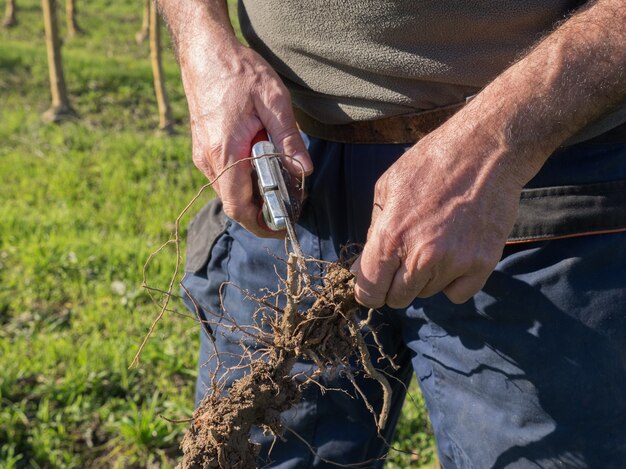
Case Studies of Successful Soil Management Projects
Examining case studies of successful soil management projects can provide valuable insights and inspiration for implementing sustainable practices on your own farm. These examples demonstrate the diverse ways in which farmers are enhancing soil health, improving productivity, and protecting the environment through innovative conservation strategies.
These case studies highlight the importance of adapting conservation practices to local conditions and working collaboratively with conservation professionals. They also underscore the long-term benefits of investing in soil health for both productivity and environmental sustainability.
Example 1: Cover Cropping in the Midwest
A farmer in the Midwest implemented a cover cropping system to improve soil health, reduce erosion, and enhance water infiltration. By planting a diverse mix of cover crops, the farmer increased soil organic matter, improved nutrient cycling, and suppressed weed growth. As a result, crop yields increased, and the farm became more resilient to drought conditions.
This case study demonstrates the benefits of cover cropping for improving soil health and enhancing agricultural productivity in the Midwest.
Example 2: No-Till Farming in the Southeast
A farmer in the Southeast adopted no-till farming practices to reduce soil disturbance, conserve soil moisture, and minimize erosion. By eliminating tillage operations, the farmer preserved soil structure, reduced fuel consumption, and improved water quality. As a result, crop yields increased, and the farm became more environmentally sustainable.
This case study illustrates the benefits of no-till farming for improving soil health and promoting environmental sustainability in the Southeast.
Resources for Sustainable Soil Management Practices
Numerous resources are available to support farmers in implementing sustainable soil management practices, including educational materials, technical assistance, and financial incentives. These resources can help you learn about the latest conservation strategies and access the support needed to implement them effectively.
The USDA, land grant universities, and conservation organizations offer a wide range of resources to help farmers improve soil health and promote sustainable agriculture. These resources can help you make informed decisions about adopting conservation practices and achieving your sustainability goals.
- USDA Natural Resources Conservation Service (NRCS): NRCS provides technical assistance, financial assistance, and educational resources to help farmers implement conservation practices.
- Land Grant Universities: Land grant universities offer research-based information, educational programs, and technical support for sustainable agriculture.
- Conservation Organizations: Conservation organizations provide advocacy, education, and technical assistance to promote sustainable soil management practices.
By utilizing these resources, farmers can access the information and support needed to implement sustainable soil management practices effectively.
| Key Point | Brief Description |
|---|---|
| 🌱 EQIP Program | Financial aid for conservation practices like cover cropping & no-till. |
| 🛡️ CSP Program | Rewards continued conservation efforts & new stewardship activities. |
| 🌍 RCPP | Partnerships to address key regional environmental priorities. |
| 🔬 On-Farm Trials | Supports the development and adoption of innovative practices. |
Frequently Asked Questions About USDA Soil Grants
Sustainable soil management involves practices that improve soil health, reduce erosion, and enhance water infiltration, ensuring long-term agricultural productivity and environmental sustainability.
Cover crops can increase soil organic matter, improve nutrient cycling, suppress weed growth, and reduce erosion, leading to healthier soils and higher crop yields as well as soil health.
Contact your local NRCS office for assistance. They will have all the forms and guides to get you started and on the right track for your grant.
No-till farming reduces soil disturbance, preserving soil structure and organic matter. This helps in retaining and cycling nutrients thus promoting sustainability.
The USDA website has a database of conservation partners by state. They can help guide you and offer hands on assistance during the process.
Conclusion
Embracing sustainable soil management practices through USDA grants can transform agricultural landscapes, ensuring long-term productivity and environmental stewardship. By understanding the available funding opportunities and implementing innovative conservation strategies, farmers can create resilient and thriving agricultural systems.



